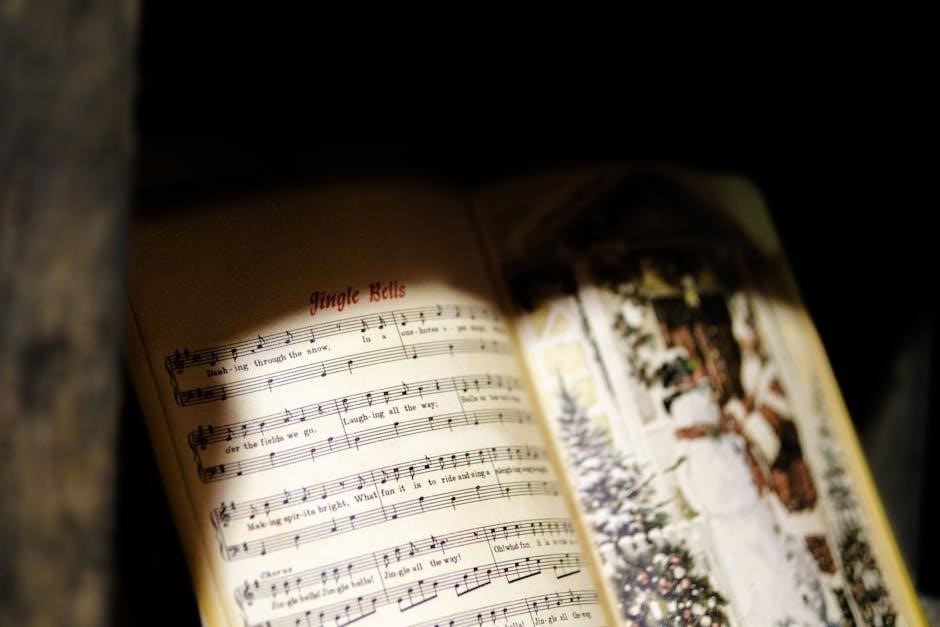A Christmas Carol, by Charles Dickens, is a timeless novella published in 1843. It explores themes of redemption, greed, and kindness, transforming Christmas celebrations forever.
Overview of “A Christmas Carol”
A Christmas Carol, written by Charles Dickens in 1843, is a novella divided into five staves (chapters). It tells the story of Ebenezer Scrooge, a miserly man who is visited by four supernatural beings on Christmas Eve. These encounters force Scrooge to confront his past, present, and future, leading to a profound transformation. The novella explores themes of redemption, greed, and kindness, offering a critique of Victorian society. Its vivid characters and moral lessons have made it a beloved tale, influencing Christmas traditions and remaining relevant today.
Charles Dickens and His Christmas Books
Charles Dickens wrote A Christmas Carol in 1843, the first of his five Christmas Books. These works aimed to evoke the spirit of the season, blending moral lessons with festive themes. Dickens’ holiday writings addressed social issues, using Christmas as a backdrop to highlight kindness and generosity. A Christmas Carol became the most enduring of these books, cementing Dickens’ legacy as a master of storytelling and moral commentary, with its themes resonating beyond the Victorian era into modern times.
Historical Context of the Novella
A Christmas Carol is set in Victorian England, a time of stark social inequality and industrialization. Dickens highlighted issues like poverty and exploitation, reflecting the era’s hardships. The novella, published in 1843, also influenced the revival of Christmas traditions, shaping modern celebrations. Dickens’ vivid portrayal of London’s struggles resonated deeply, making the story a timeless critique of societal ills while offering hope for redemption and kindness.

Plot Summary
A Christmas Carol follows Ebenezer Scrooge’s transformative journey. Visited by Marley’s ghost and three spirits, Scrooge confronts his past, present, and future, embracing kindness and redemption by Christmas morning.
Stave One: Marley’s Ghost
The novella opens on a cold Christmas Eve in London. Ebenezer Scrooge, a miserly old man, refuses his nephew Fred’s dinner invitation and dismisses Christmas as a waste. His clerk, Bob Cratchit, endures harsh working conditions. As night falls, Scrooge is visited by the ghost of his former partner, Jacob Marley, who has been dead for seven years. Marley, condemned to wander in heavy chains, warns Scrooge he will be haunted by three spirits that night, foretelling a chance for redemption. This eerie encounter sets the stage for Scrooge’s transformative journey;
Stave Two: The First of the Three Spirits
The first spirit, the Ghost of Christmas Past, appears to Scrooge as a gentle, ethereal woman with a candle. She forces Scrooge to confront his lonely childhood, his unrequited love for Belle, and the choices that hardened his heart. Through these memories, Scrooge begins to see how his obsession with wealth led to his isolation. The spirit’s revelations evoke both regret and a glimmer of hope, setting the foundation for Scrooge’s potential redemption. Her presence marks the beginning of Scrooge’s emotional journey to reclaim his lost humanity.
Stave Three: The Second of the Three Spirits
The Ghost of Christmas Present, a jovial giant in a green robe, appears to Scrooge. He reveals visions of those close to Scrooge, including the Cratchits and his nephew Fred, highlighting their struggles and joys. The spirit also shows two children, Ignorance and Want, symbolizing the dangers of societal neglect. Scrooge begins to feel empathy, particularly for Tiny Tim, and starts to recognize the consequences of his selfishness. This stave deepens Scrooge’s emotional transformation, urging him to reflect on his impact on others and the world around him.
Stave Four: The Last of the Three Spirits
The final spirit, the Ghost of Christmas Yet to Come, appears to Scrooge as a dark, silent figure. This spirit reveals a grim future where Scrooge has died, and his possessions are stolen by those who do not mourn his passing. The Cratchits are shown grieving the loss of Tiny Tim, emphasizing the consequences of Scrooge’s unkindness. Horrified, Scrooge begs for a chance to alter his destiny, marking a turning point in his journey toward redemption and compassion.
Stave Five: The End of the Journey
Awakening on Christmas morning, Scrooge is transformed, filled with joy and determination to change his life. He anonymously sends a large goose to the Cratchits and increases Bob’s salary. Visiting his nephew, he joins the Christmas feast, showcasing his newfound kindness. Scrooge’s redemption is complete as he becomes a kinder, generosity-filled man. The novella concludes with Scrooge’s commitment to honor Christmas in his heart, embodying the spirit of love, compassion, and the possibility of personal transformation.

Themes and Symbolism
Redemption, greed, charity, and social inequality are central themes. The three spirits symbolize past, present, and future, guiding Scrooge’s transformation. The chain Marley wears represents greed’s burden.
Redemption and Personal Transformation
Redemption and personal transformation lie at the heart of A Christmas Carol. Ebenezer Scrooge’s journey from a miserly, cold-hearted creditor to a kind and generous man is the novella’s central focus. Through the visitations of the three spirits, Scrooge confronts his past mistakes, current isolation, and potential future consequences. The Ghost of Christmas Past reveals his lost opportunities for love and connection, while the Ghost of Christmas Present shows him the struggles of others, including the Cratchits. The Ghost of Christmas Yet to Come compels Scrooge to reevaluate his life and seek redemption. Dickens portrays transformation as a powerful and achievable process, emphasizing the importance of empathy, kindness, and second chances. Scrooge’s metamorphosis serves as a timeless message about the human capacity for change and the transformative power of compassion.
Greed and Its Consequences
Greed and its consequences are central themes in A Christmas Carol. Ebenezer Scrooge’s obsession with wealth has led to his moral decay and isolation. His relentless pursuit of money blinds him to the suffering of others, exemplified by his mistreatment of Bob Cratchit and refusal to support charitable causes. Jacob Marley’s ghost serves as a haunting warning, revealing the consequences of a life consumed by greed. Dickens portrays greed as a destructive force, highlighting its impact on personal relationships and societal well-being. Scrooge’s transformation underscores the dangers of prioritizing wealth over humanity.
Importance of Charity and Kindness
Charity and kindness are pivotal in A Christmas Carol, as Dickens emphasizes their transformative power. The novella highlights the contrast between Scrooge’s selfishness and the generosity of those around him, such as his nephew Fred and the charitable solicitors. Through Scrooge’s redemption, Dickens illustrates how acts of kindness and compassion can restore humanity and connections. The Cratchit family, despite their poverty, embody warmth and love, further underscoring the importance of kindness over material wealth. Dickens advocates for a society that values empathy and generosity, especially during Christmas.
Social Inequality in Victorian England
Dickens critiques the stark social inequality of Victorian England in A Christmas Carol. The novella portrays the contrasting lives of the wealthy, like Scrooge, and the struggling working class, exemplified by Bob Cratchit and his family. Dickens highlights the exploitation of the poor, inadequate wages, and lack of access to education and healthcare. Through the character of Tiny Tim, he emphasizes the human cost of poverty and the need for systemic change. The story reflects Dickens’ concern for social justice and his hope for a more compassionate society.

Characters

A Christmas Carol features Ebenezer Scrooge, a miserly protagonist, Jacob Marley, his ghostly partner, Bob Cratchit, the underpaid clerk, and his family, including Tiny Tim. The three spirits symbolize Scrooge’s journey toward redemption, driving the novella’s emotional core.
Ebenezer Scrooge: The Protagonist
Ebenezer Scrooge, the novella’s central character, is a miserly, cold-hearted creditor who embodies greed and isolation. His disdain for Christmas and humanity is evident in his treatment of others, including his nephew Fred and clerk Bob Cratchit. Haunted by the ghost of Jacob Marley and the three spirits, Scrooge undergoes a profound transformation. Through these supernatural encounters, he confronts his past, present, and future, revealing his deep-seated loneliness and regret. Ultimately, Scrooge’s journey leads to redemption, as he embraces kindness, generosity, and a renewed appreciation for life and humanity.
Jacob Marley: The Warning from Beyond
Jacob Marley, Scrooge’s deceased business partner, appears as a ghost in the novella, condemned to wander Earth wearing heavy chains forged from his greedy deeds. His visit to Scrooge serves as a chilling warning, expressing regret for his own miserly life and urging Scrooge to alter his path. Marley’s haunting presence emphasizes the consequences of unchecked greed and the importance of kindness, setting the stage for Scrooge’s transformative journey. His spectral appearance and tragic fate underscore Dickens’ themes of moral accountability and redemption.

Bob Cratchit and the Cratchit Family
Bob Cratchit, Ebenezer Scrooge’s underpaid clerk, embodies kindness and resilience despite his hardships. His family, though impoverished, finds joy in their modest Christmas celebration. Tiny Tim, Bob’s ailing son, symbolizes hope and innocence, while Peter and the other children represent the struggles of poverty. The Cratchits’ optimism contrasts sharply with Scrooge’s greed, highlighting the novella’s themes of social inequality and the importance of charity. Their story deeply moves Scrooge, inspiring his transformation and prompting him to improve Bob’s wages and provide a lavish Christmas feast for the family.
The Three Spirits: Their Roles and Significance
The three spirits in A Christmas Carol—the Ghost of Christmas Past, Present, and Yet to Come—play pivotal roles in Ebenezer Scrooge’s redemption. The Ghost of Christmas Past reveals Scrooge’s unhappy youth, highlighting lost opportunities for love and connection. The Ghost of Christmas Present shows Scrooge how his greed impacts others, such as the Cratchits, while the Ghost of Christmas Yet to Come reveals a bleak future if Scrooge does not change. Together, they guide Scrooge toward self-reflection, transforming him into a kinder, more compassionate man. Their visits are central to the novella’s message of personal transformation and redemption.

Analysis and Reception
A Christmas Carol was a massive success, praised for its vivid characters and moral themes. Its exploration of greed, kindness, and social inequality resonated deeply, shaping Victorian values and enduring as a literary classic.
Critical Reception and Legacy
A Christmas Carol received widespread acclaim upon its release, praised for its profound social commentary and vivid characterization. Critics highlighted Dickens’s ability to blend moral lessons with engaging storytelling, ensuring its enduring relevance. The novella’s exploration of greed, kindness, and redemption resonated deeply with Victorian society, influencing public perception of Christmas and social inequality. Its legacy endures through countless adaptations, solidifying its place as a literary masterpiece and a cornerstone of holiday tradition, continuing to inspire new generations with its timeless themes and universal appeal.
Adaptations and Interpretations
A Christmas Carol has inspired countless adaptations across film, theater, and television, each offering unique interpretations of Dickens’s timeless tale. The 1951 film starring Alastair Sim and the 1992 Disney adaptation with Jim Carrey are particularly notable. Stage productions often emphasize the novella’s emotional depth, while modern retellings explore fresh perspectives, such as comedic parodies or futuristic settings. These adaptations highlight the story’s versatility and universal appeal, ensuring its continued relevance in contemporary culture and solidifying its status as a beloved holiday classic that transcends generations and mediums.

Modern Relevance of the Novella
A Christmas Carol remains profoundly relevant today, as its themes of greed, kindness, and redemption continue to resonate in modern society. The novella’s critique of social inequality and its emphasis on compassion align with contemporary discussions on poverty, wealth distribution, and mental health. Scrooge’s transformation mirrors modern self-reflection and the pursuit of personal growth. Dickens’s vivid portrayal of Victorian England also serves as a reminder of the ongoing struggle for fairness and justice. The story’s universal message ensures its enduring impact, making it a timeless reflection of humanity’s shared values and aspirations.
